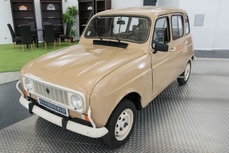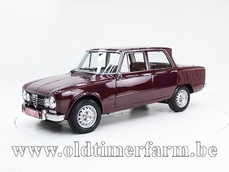Renault 4 '79 1979
General description :
The Renault 4 or R4 was produced between 1961 and 1994. It is renault's first front-wheel drive passenger car. In France one speaks of the 4L (pronounced "Quatrelle" or "Quatre ailes", which means "four wings"). In 1948 Renault's big competitor Citroën came on the market with the 2 CV. Renault had to respond to this, but in the meantime could also study the strengths and weaknesses of the 2CV. In the spring of 1956, Renault managing director Pierre Dreyfus started a project for a car that would be larger than the 2CV and that would also be more suitable for use in the city. The new car had to succeed the rear-wheel-damaged Renault 4 CV. It had to be suitable for everyone: a family car, a car for women, for farmers, for the city. Only in 1961 the Renault 4 was presented at the Salon de l'Automobile in Paris, in the Luxe (L) version, hence the name 4L, which is common in France. The first versions featured the 750cc engine of the Renault 4CV and a newly developed three-speed gearbox, the first gear of which was not synchronized. With this gearbox, the Renault 4 was behind the now thirteen-year-old Citroën 2CV, which had four instead of three gears. The body was screwed onto a chassis, while its predecessor, the 4CV, already had a self-supporting body. The chassis ran the risk of bending if the (firmness-giving) bodywork was removed; nevertheless, this construction gave Renault an advantage. On the same R4 chassis, Renault was later able to assemble the Renault 6. The R4 had independent suspension on all four wheels, all equipped with suspension by means of torsion bars. The wheelbase is 4 cm shorter on the left than on the right, making it very easy to perform the rear torsion suspension, without affecting the steering of the car. The handling of a Renault 4 is experienced as very comfortable, more comfortable than some modern cars. This is partly due to the smooth torsion bar suspension. During the production of the R4, the model was considered by many to be a station wagon, but in retrospect it might be better to call it one of the first hatchbacks. To date, the R4 did not get the cult status that the Citroën 2CV does, probably because it was the most successful French car of all time. The car was so common that preserving or cultivating the car simply wasn't done. Only in recent years has the cult status of the R4 increased. In the Netherlands, the R4 was for sale until 1986, but production continued in Slovenia, among others, at Revoz until 1993. A total of more than eight million Renaults 4 were produced. Despite its long production time, little was changed in the appearance of the Renault 4. In 1967, the chrome-plated "harp" grille was replaced by an aluminium grille with a Renault logo placed off-centre. There were hardly any changes in the sheet metal: the hood was slightly modified on versions with the 1108 cc engine, and the upper hinges of the door were moved from the outside to the inside in 1982, while the hinges of the tailgate were also reduced. The initially somewhat sm. all bumpers had their final shape from 1967. The interior was nice with comfortable seating, powerful heating and efficient ventilation. The sliding windows gave the R4 an extra character for some drivers, for others it was a sign of an outdated design. The gear lever distinguishes the Renault 4 from other cars, because it is not on the ground, but in the dashboard. The design was copied from the Citroën 2CV, and the result was a flat floor, with more space. The gear lever passed through the dashboard, on the engine and radiator to the gearbox, in front of the engine compartment. As is often the case with a different design, the gear lever was also criticized by journalists, although it was easy to handle. Despite the great success of the Renault 4 (or perhaps as a result of that), Renault has invested heavily in the development of small cars. The Renault 6 and Renault 5 were designed while the Renault 4 was still selling very well, and the R5 was a completely different type of car. This made the Renault 4 a bridge between small cars (2CV, Mini) and the three-door sports car (said Renault 5 and later also the Peugeot 205).
http://www.oldtimerfarm.be/en/collection-cars-for-sale/6657/renault-r4tl-79.php
1979 Renault 4 '79 is listed sold on ClassicDigest in Aalter by Oldtimerfarm Dealer for €10950.
Car Facts
Car type : Car Make : Renault Model : 4 Model Version : '79 Engine size : 0.0 Model Year : 1979 Location : Aalter
Sold
Seller Information
Sold
People who viewed this Renault 4 also viewed similar Renault listed at ClassicDigest
Other cars listed for sale by this dealer
About Renault
Ah, Renault, a name that's as French as a croissant and as ingrained in automotive history as a baguette in a Parisian café. Let's take a leisurely drive through the annals of this storied manufacturer, shall we?Our story begins in the late 19th century when the Renault brothers, Louis, Marcel, and Fernand, decided to put their inventive minds to work. In 1898, they introduced their very first car, the Renault Voiturette. It was a petite, rear-engined contraption that looked like something Jules Verne might have designed. This pint-sized pioneer laid the foundation for Renault's automotive legacy.
Now, if we're talking about influential Renault models, we mustn't overlook the Renault 4. Launched in 1961, it was the French answer to the Volkswagen Beetle. The Renault 4 was practical, versatile, and designed to handle the rough and tumble of rural France. It was as much at home in the city as it was on a farm, a true embodiment of French pragmatism.
But let's not forget the Renault 5, or "Le Supercinq" as it was known in France. Introduced in the mid-'70s, this little hatchback was a design sensation. Its quirky, angular lines and cheeky personality made it an instant hit. It was economical, fun to drive, and became an icon of French urban life.
Then came the Renault Espace in 1984. It was one of the pioneers of the MPV (multi-purpose vehicle) segment. The Espace was designed for families who wanted the practicality of a van without sacrificing the comfort of a car. It was the beginning of a new era in family transport.
And let's not forget the Renault Twingo, introduced in 1992. It was a small city car that broke the mold with its innovative design and rear-engine layout. The Twingo was proof that small cars could be stylish and practical, and it was a hit with urban dwellers across Europe.
Now, if you want to talk about a true game-changer, it's the Renault Clio. First introduced in 1990, the Clio became a European favorite. It combined style, performance, and affordability in a way that few cars could match. It's the kind of car that's as comfortable on the Champs-Élysées as it is navigating the narrow streets of a French village.
But, of course, we can't forget the Renault Megane. It's been a stalwart of the compact car segment since its debut in 1995. With its distinctive rear-end design and a range of engines to suit every taste, the Megane has remained a strong contender in a competitive market.
So there you have it, a leisurely tour through the history of Renault, a company that has always managed to infuse a touch of French flair into the automotive world. Renault has given us cars that are as diverse as the French countryside itself, from practical workhorses to stylish city slickers. It's a brand that's as much a part of France's cultural tapestry as a bottle of Bordeaux or a game of pétanque. Vive la Renault!

























